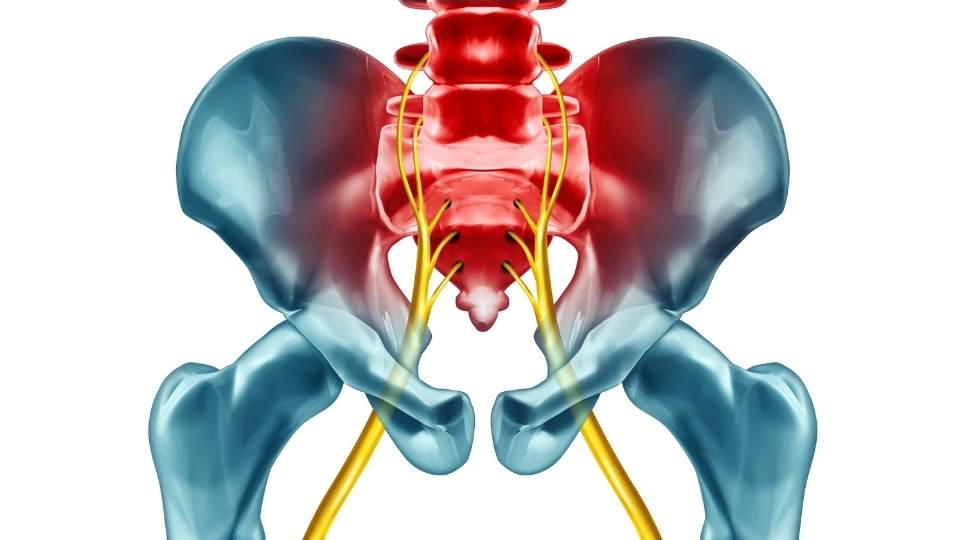I get this question a lot in practice and amongst family members “can physio make sciatica worse”, and the short answer is “no, a physio cannot make sciatica worse”
When it comes to sciatica, you want a physio that understands the condition and knows how to treat it effectively.
A physio who can get you out of pain and discomfort as quickly as possible because the lower back and leg pain, most associated with sciatica, can be very debilitating and can lead to sleep distributions, mood changes, and terrible concentrating.

There are many misconceptions about sciatica, and some people might have had bad experiences with physios in the past. The aim of this blog post is to question and dive into the details of what do to for sciatica, and why some people may have had unpleasant experiences.
Can Physio Make Sciatica Worse?
I get this question a lot in practice and amongst family members “can physio make sciatica worse”, and the short answer is “no, a physio cannot make sciatica worse”. People who have had an unpleasant experience with physios may be wondering if it’s true that physios can actually worsen sciatica, but in my experience physio is a very effective way of treating the symptoms and causes of sciatica. You can expect to feel some soreness after physio, and I will get into that a little later on.
Your physio might provoke or worsen your symptoms, only for 1 to 2 seconds, to assess the current sensitivity of the sciatic nerve and use this as a starting point for treatment. They might perform what is called a ‘Straight Leg Raise or SLR’ or the ‘Slump Test’.

However, the form of therapy must be individually tailored for it to work, and for you to achieve the outcomes you are looking for.
What Is Sciatica?
I have explained this in more detail on the sciatica page in common conditions, but I will also quickly explain it here. Sciatica is a nerve-related problem in which the sciatic nerve which runs from your lower back to the soles of your feet becomes inflamed, irritated, or compressed.

How Can Physio Help Sciatica?
Not only does physio not make sciatica worse, but it also makes it better, improve function, sleep, performance at work, and mood, in a number of different ways. Physiotherapists are able to help people who are suffering from sciatica by looking at ways in which you might be causing the sciatic pain, or in other words, what is causing the nerve to become inflamed, irritated, or compressed.

Physio For Sciatica
Physio can help treat and prevent sciatica with a number of different techniques, but it always comes down to lifestyle changes, always.
- Lifestyle Changes.
- Exercise Therapy.
- Laser Therapy.
- Hands-on techniques: Massage therapy and Joint Mobilizations.
- Joint traction & Spinal Decompression.
- Education & Advice.
Are There Any Risks In Looking A Physio For Sciatica?
If you are worried about the risks of physiotherapy, my advice to you would be to take control of your own therapy, make sure you understand why your physio is giving you certain exercises, and if you can be concerned don’t be afraid to ask questions. It is a team effort, your physio should meet you halfway, and work with you.
Clients have come to my clinic after having a bad experience with other physio’s, their pain increased after one session, or they have the belief that the physio ‘moved something out of place’, and this made them worse.

The first thing I do is try and understand how this makes them feel, and I simply start over, with a new approach, something that they have not tried before because there is no point trying something that has not worked in the past.
Then I try to give them a more positive belief around physio and set realistic expectations for the first session. I explain that nothing is out of place, the particular technique or maneuver that your previous physio performed may have been too firm and not right for you and your body at that time.
I don’t know anything about the physio they say before, and I am sorry that they had a negative experience, and I explain what we, myself, and my client are going to do today and how they might feel after the session.
Is It Normal To Feel Sore After A Physio Session?
Yes, it is very normal to feel sore after a physio session, this is because your body is adapting and changing. it might feel like this muscle soreness, similar to what you might feel after a hard workout or it might feel like your familiar pain.

Soreness after a physio session also depends on the kind of therapy or techniques the physio used and the stage of our rehabilitation. In the early stages of rehabilitation is it more common to experience some soreness after physio because the area is usually most sensitive, irritated, or tense in the beginning.
If your physio does a lot of hands-on techniques that push the joint a little to stimulate increasing to a range of motion, your might feel a little soreness afterward. Or if your physio introduces new exercises during a session you might also feel some DOMS (delayed onset muscle soreness) in the following few days, but this is a sign that the exercise was effective.
Is Sciatica A Chronic Condition?
It can be if it’s being caused by something else going on in your body and you have not addressed the root cause of sciatic pain yet. In which case, the physio will get rid of your symptoms temporarily, but once they stop treatment, sciatica can come back again. This is why it’s important to find the root cause of sciatic pain so you can prevent sciatic symptoms from coming back in the future.
Lifestyle Changes For Sciatica
The cause of sciatica is usually lifestyle-related. So, it is important to look at what changes can I make in my life to reduce stress and increase my tolerance to normal demands or build resilience, both physically and emotionally. Here are some aspects of lifestyle you might look into within your own life:
- Diet.
- Smoking.
- Alcohol.
- Sleep.
- Degree of activity.
- Degree of inactivity.
- Work demands.
- Relaxation time.
- ‘Me’ time.
- Hobbies.
- Posture.
The body is all about cycles and rhythms, finding balance, and stress happens, ask yourself “what tools do I have to manage stress when it comes?”.

Conclusion
The aim of this blog was to give you a few ideas of what sciatica is, the different types and causes of sciatic pain, how it can be treated or managed, and most importantly that physio cannot make sciatica worse. So if you have any questions about this topic please feel free to get in touch with me!
I hope this blog has been helpful! Thank You, I will keep doing my best to help out as much as possible.
Thanks for reading!

References
[1] https://www.sciencedirect.com/science/article/abs/pii/S1521694209001417?via%3Dihub
[2] https://www.sciencedirect.com/science/article/abs/pii/S1521694210000033




